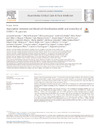Please use this identifier to cite or link to this item:
https://accedacris.ulpgc.es/jspui/handle/10553/106217
| Title: | Association between red blood cell distribution width and mortality of COVID-19 patients | Authors: | Lorente, Leonardo Martín, María M. Argueso, Mónica Sole Violan, Jorge Perez, Alina Marcos Y Ramos, José Alberto Ramos-Gómez, Luis López, Sergio Franco, Andrés González-Rivero, Agustín F. Martín, María Trujillo González, Verónica Cristina Alcoba-Flórez, Julia Rodriguez, Miguel Ángel Riaño-Ruiz, Marta Guillermo O Campo, Juan González, Lourdes Cantera, Tamara Ortiz-López, Raquel Ojeda, Nazario Rodríguez Pérez, Aurelio Eduardo Domínguez, Casimira Jiménez, Alejandro |
UNESCO Clasification: | 32 Ciencias médicas 3202 Epidemologia |
Keywords: | Red blood cell distribution width COVID-19 Patients Mortality Outcome |
Issue Date: | 2021 | Journal: | Anaesthesia, Critical Care & Pain Medicine | Abstract: | Purpose. We have previously reported an association between high red blood cell distribution width (RDW) and mortality in septic and brain infarction patients. However, no association between RDW and mortality in coronavirus disease 2019 (COVID-19) patients has been reported so far; thus, the objective of this study was to determine if that association exists. Methods. Prospective and observational study carried out in 8 Intensive Care Units from 6 hospitals of Canary Islands (Spain) including COVID-19 patients. We recorded RDW at ICU admission and 30-day survival. Results. We found that patients who did not survive (n = 25) compared to surviving patients (n = 118) were older (p = 0.004), showed higher RDW (p = 0.001), urea (p < 0.001), APACHE-II (p < 0.001) and SOFA (p < 0.001), and lower platelet count (p = 0.007) and pH (p = 0.008). Multiple binomial logistic regression analysis showed that RDW was associated with 30-day mortality after controlling for: SOFA and age (OR = 1.659; 95% CI = 1.130–2.434; p = 0.01); APACHE-II and platelet count (OR = 2.062; 95% CI = 1.359–3.129; p = 0.001); and pH and urea (OR = 1.797; 95% CI = 1.250–2.582; p = 0.002). The area under the curve (AUC) of RDW for mortality prediction was of 71% (95% CI = 63–78%; p < 0.001). We did not find significant differences in the predictive capacity between RDW and SOFA (p = 0.66) or between RDW and APACHE-II (p = 0.12). Conclusions. Our study provides new information regarding the ability to predict mortality in patients with COVID-19. There is an association between high RDW and mortality. RDW has a good performance to predict 30-day mortality, similar to other severity scores (such as APACHE II and SOFA) but easier and faster to obtain. | URI: | https://accedacris.ulpgc.es/handle/10553/106217 | ISSN: | 2352-5568 | DOI: | 10.1016/j.accpm.2020.10.013 | Source: | Anaesthesia, Critical Care & Pain Medicine [ISSN 2352-5568], v. 40 (1), 100777, (Febrero 2021) |
| Appears in Collections: | Artículos |
WEB OF SCIENCETM
Citations
43
checked on Jun 8, 2025
Page view(s)
92
checked on Jan 27, 2024
Download(s)
152
checked on Jan 27, 2024
Google ScholarTM
Check
Altmetric
Share
Export metadata
Items in accedaCRIS are protected by copyright, with all rights reserved, unless otherwise indicated.
